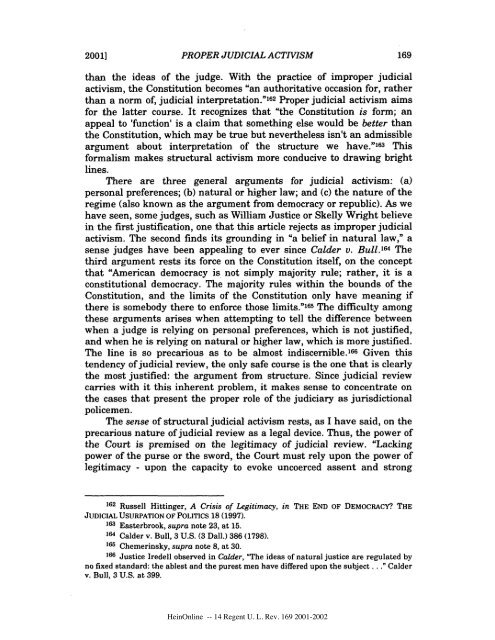Judicial ReEngineering
Judicial ReEngineering
Judicial ReEngineering
You also want an ePaper? Increase the reach of your titles
YUMPU automatically turns print PDFs into web optimized ePapers that Google loves.
2001]<br />
PROPER JUDICIAL ACTIVISM<br />
than the ideas of the judge. With the practice of improper judicial<br />
activism, the Constitution becomes "an authoritative occasion for, rather<br />
than a norm of, judicial interpretation." 162 Proper judicial activism aims<br />
for the latter course. It recognizes that "the Constitution is form; an<br />
appeal to 'function' is a claim that something else would be better than<br />
the Constitution, which may be true but nevertheless isn't an admissible<br />
argument about interpretation of the structure we have." 163 This<br />
formalism makes structural activism more conducive to drawing bright<br />
lines.<br />
There are three general arguments for judicial activism: (a)<br />
personal preferences; (b) natural or higher law; and (c) the nature of the<br />
regime (also known as the argument from democracy or republic). As we<br />
have seen, some judges, such as William Justice or Skelly Wright believe<br />
in the first justification, one that this article rejects as improper judicial<br />
activism. The second finds its grounding in "a belief in natural law," a<br />
sense judges have been appealing to ever since Calder v. Bull. 1 6 The<br />
third argument rests its force on the Constitution itself, on the concept<br />
that "American democracy is not simply majority rule; rather, it is a<br />
constitutional democracy. The majority rules within the bounds of the<br />
Constitution, and the limits of the Constitution only have meaning if<br />
there is somebody there to enforce those limits." 165 The difficulty among<br />
these arguments arises when attempting to tell the difference between<br />
when a judge is relying on personal preferences, which is not justified,<br />
and when he is relying on natural or higher law, which is more justified.<br />
The line is so precarious as to be almost indiscernible. 166 Given this<br />
tendency of judicial review, the only safe course is the one that is clearly<br />
the most justified: the argument from structure. Since judicial review<br />
carries with it this inherent problem, it makes sense to concentrate on<br />
the cases that present the proper role of the judiciary as jurisdictional<br />
policemen.<br />
The sense of structural judicial activism rests, as I have said, on the<br />
precarious nature of judicial review as a legal device. Thus, the power of<br />
the Court is premised on the legitimacy of judicial review. "Lacking<br />
power of the purse or the sword, the Court must rely upon the power of<br />
legitimacy - upon the capacity to evoke uncoerced assent and strong<br />
162 Russell Hittinger, A Crisis of Legitimacy, in THE END OF DEMOCRACY? THE<br />
JUDICIAL USURPATION OF POLITICS 18 (1997).<br />
163 Easterbrook, supra note 23, at 15.<br />
164 Calder v. Bull, 3 U.S. (3 Dall.) 386 (1798).<br />
165 Chemerinsky, supra note 8, at 30.<br />
166 Justice Iredell observed in Calder, "The ideas of natural justice are regulated by<br />
no fixed standard: the ablest and the purest men have differed upon the subject..." Calder<br />
v. Bull, 3 U.S. at 399.<br />
HeinOnline -- 14 Regent U. L. Rev. 169 2001-2002

















